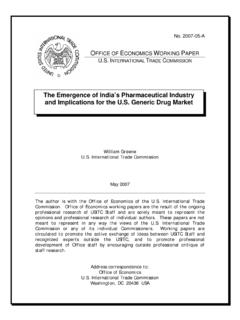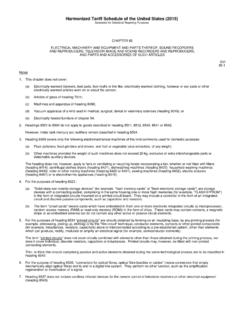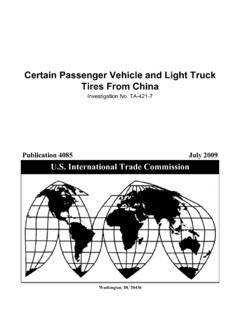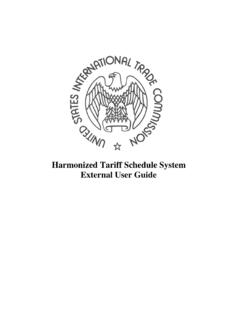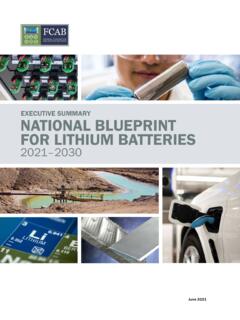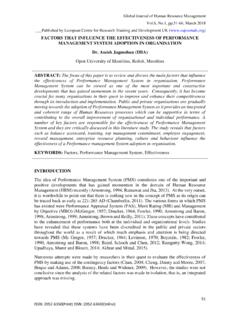Transcription of Semiconductor Manufacturing Equipment
1 SemiconductorManufacturingEquipmentUSITC Publication 3868 June 2006 OFFICE OF International Trade CommissionWashington, DC 20436 UNITED STATES INTERNATIONAL TRADE COMMISSIONThis report was prepared principally byHeather Sykes and Falan Yinugunder the direction ofMichael Anderson,Chief, Advanced Technology and Machinery DivisionRobert Carr,Chief, Natural Resources and Metals DivisionAddress all communications toSecretary to the CommissionUnited States International Trade CommissionWashington, DC 20436 COMMISSIONERSS hara L. Aranoff, Vice ChairmanDaniel R. Pearson, ChairmanJennifer A. HillmanStephen KoplanDeanna Tanner OkunCharlotte R. A. RogowskyDirector of OperationsKaren Laney-CummingsDirector of Industries 1 The information and analysis provided in this report are for the purpose of this report in this report should be construed to indicate how the Commission would find in aninvestigation conducted under statutory authority covering the same or similar subject 1991, the United States International Trade Commission initiated its current Industry andTrade Summary series of informational reports on the thousands of products imported intoand exported from the United States.
2 Each summary addresses a differentcommodity/industry area and contains information on product uses, and foreignproducers, and customs treatment. Also included is an analysis of the basic factors affectingtrends in consumption, production, and trade of the commodity, as well as those bearing onthe competitiveness of industries in domestic and foreign markets. This report onsemiconductor Manufacturing Equipment covers the period 2001 through of the SME of industry trends and industry and of firms and industry and development remains s valuable role ..12 Pricing ..13 factors affecting characteristics and factors affecting demand.
3 15 Shipments, consumption, and trade .. and foreign trade trade issues affecting the industry ..22 Europe ..23ivCONTENTS ContinuedPageForeign market ..25 Taiwan ..26 China .. description of the Semiconductor Manufacturing : Harmonized Tariff Schedule subheading, description, col. 1 rate of duty as of January 1, 2006, imports, 2005, and exports, and wage rates for production workers in the SME industry, 10 SME companies ranked by 2005 10 Semiconductor companies ranked by capital spending, : shipments, exports of domestic merchandise, imports forconsumption, apparent consumption, the ratio of imports to consumption, andthe ratio of exports to shipments, : exports of domestic merchandise, imports for consumption, andmerchandise trade balance, by selected countries, : exports of domestic merchandise, by principal product groups.
4 Imports for consumption, by principal product groups, product segments of the SME SME sales by product type, between the global SME and Semiconductor shipment data for SME, industry employment, SME production by country/region, spending on SME by country/region, Formation of a silicon Front-end wafer fabrication stages of integrated circuit fabrication ..A-6vCONTENTS ContinuedPageBoxes1. Consumer of SME: the Semiconductor A new Harmonized Schedule (HS) heading for SME in The growth of the Semiconductor foundry industry in report addresses trade and industry conditions for Semiconductor Manufacturing Equipment (SME)for the period 2001 through 2005. The SME industry is strongly competitive in most Equipment and is one of the fewindustries in which the United States has a substantial trade surplus ($ billion in 2005).
5 Manufacturers share worldwide production and technological leadership with Europeanand Japanese companies. The SME industry is dominated by the major top-tier firms. In 2004, the top 10 worldwideSME companies accounted for almost 58 percent of total industry sales. SME firms withinthe United States are widely dispersed, although the majority are in California. From 2001through 2005, the industry witnessed concentration, specialization, and a rapid decrease inemployment. Research and development and marketing are extremely important to theindustry. The trade surplus in SME grew from $ billion in 2001 to $ billion in 2005. Thelargest gains were made in bilateral trade with Taiwan, Korea, China, and Singapore.
6 Mostcountries involved in SME trade are signatories to the Information Technology Agreement,which eliminated tariffs for SME. Semiconductor producers are the main consumers of SME. They need SME to outfit newlyconstructed Semiconductor fabrication facilities as well as to replace and upgrade existingequipment. Taiwan, Korea, and Japan were the largest markets for SME in 2005. Asiahas grown as the major market for SME due in part to the increase in new fabrication facilityconstruction from 2001 through 2005. Three major long-term trends are driving Equipment sales: (1) transition to larger silicon wafersizes (from 200 mm diameter wafers to 300 mm diameter wafers), allowing more surface areaon which to build chips, (2) the use of and smaller-micron lithography to improve thefunctionality of chips while reducing their size, and (3) the use of copper for interconnectsinstead of aluminum because of its higher conductivity.
7 These changes lead to improved chipperformance and Manufacturing efficiency, spur Equipment investment by semiconductorcompanies, and, in turn, drive the SME industry. 1 Semiconductor devices are commonly referred to by many other names includingsemiconductors, integrated circuits, ICs, microchips, and chips. This report uses these termsinterchangeably. 2 Dale W. Jorgenson, Mun S. Ho, and Kevin J. Stiroh, Potential Growth of the Economy:Will the Productivity Resurgence Continue? Business Economics, January 2006, vol. 41 issue 1,7 16. 3 In the past few years, some SME companies have diversified into the flat panel displayequipment market, as the technology for making flat panel displays is similar for makingsemiconductors.
8 See Colin McArdle and Nelson Wang, Semiconductor Equipment , Standard &Poor s Industry Surveys, November 17, 2005, 4. Sources of information available to Commissionstaff on the Semiconductor Manufacturing Equipment industry are limited. Therefore, Commissionstaff has relied on a limited number of sources, including the Standard & Poor s Industry Survey,for parts of this report. 4 For more information on the Semiconductor industry, please refer to Box Manufacturing Equipment (SME) is used in perhaps the most complex andadvanced Manufacturing process in the world, the production of Semiconductor , such as microprocessors and memory devices, are used in a wide varietyof manufactured products, including personal computers, telecommunications Equipment ,and many common consumer electronics goods.
9 Chip-containing products have proliferatedin the past decade and have been a major contributor to increased productivity in virtuallyevery sector of the SME has been a critical contributor to this refers to all Equipment used to produce Semiconductor devices. The technology usedin this Equipment is constantly being improved because of consumer demand for higherperforming semiconductors. Rapid advances in chip technology can render existing chipsand the SME used to make them obsolete in just a few years, and an aggressive research anddevelopment (R&D) program is essential to maintaining competitiveness in the SMEindustry. The SME industry is one of the few industries that consistently maintainsa substantial trade surplus, because firms are strongly competitive in R&D and theproduction of most types of Equipment .
10 The majority of all SME is used for manufacturingsemiconductor devices; few other end uses SME industry is globally oriented, with a high degree of foreign investment and closeinterrelationship between domestic and foreign SME producers. The health of the SMEindustry is tied to the Semiconductor industry4 and follows its global fortunes. This summarycovers the SME industry for the period 2001 2005. It describes the SME productionprocesses, profiles the and foreign industries and markets, and provides trade andtariff information for the CoverageThe SME industry consists of two broad categories: front-end and back-end Equipment (figure 1). Front-end SME is used to make the silicon wafers and create the semiconductorchips on the wafers.
